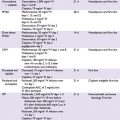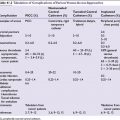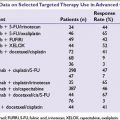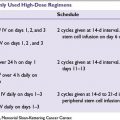STAGING AND PROGNOSIS
The most commonly used staging methods include the Rai, modified Rai, and the Binet staging systems. Prognosis based on the modified Rai staging system is outlined in Table 24.1. There are a number of prognostic factors for CLL. Those associated with an inferior outcome include the cytogenetic abnormalities detected by fluorescent in situ hybridization of deletion (del) 11q and del 17p, an elevated serum β-2-microglobulin level ≥4, unmutated immunoglobulin variable region heavy chain genes (IgVH), overexpression of the ZAP-70 >20%, expression of CD38 >30%, and advanced-stage disease. Trisomy 12 and normal cytogenetics are associated with an intermediate outcome, while del 13q is associated with a favorable outcome. The utility of these factors lies in prognosis and is usually not used to determine when to initiate treatment or the choice of regimen.
Computerized tomography (CT) is not required at diagnosis or for staging purposes, but may be useful to evaluate the presence of internal enlarged lymph nodes unable to be palpated by physical examination. Patients with clinical stage 0 disease, but stage I by CT, often behave more like the latter. Contrast-enhanced CT has a higher sensitivity of detecting CLL than PET/CT. At this time there is no role for positron emission tomography (PET) scanning in CLL, except to assess for a potential transformation to a high-grade lymphoma.
COMPLICATIONS
Patients with CLL can develop infections, high-grade transformation, and are at an increased risk for other malignancies. Hematologic complications include anemia or thrombocytopenia due to marrow involvement, treatment effect, splenic sequestration, AIHA, pure red cell aplasia, and immune-mediated thrombocytopenia. AIHA can be due to the CLL itself or to fludarabine, which is commonly used in the treatment of this disease. Pure red cell aplasia, although rare, is possibly caused by suppressor T cells. Cyclosporine may be effective with a reticulocyte response within a few weeks. Frequent infections, often sinopulmonary, are often related to immunosuppressive treatments, hypogammagobulinemia, inadequate humoral response, and impaired complement activation. Transformation to Richter syndrome (large B-cell lymphoma), PLL, ALL, and multiple myeloma occurs in 10% to 15% of cases. Patients are also at increased risk of developing other malignancies of sites such as the gastrointestinal tract, lung, and skin. Other chemotherapeutics, such as cyclophosphamide or chlorambucil, are associated with secondary malignancies such as AML and MDS.
TREATMENT
CLL often exhibits an indolent course, not requiring treatment at diagnosis. The indications for treatment of CLL per the NCI-Sponsored WG guidelines include the following:
■Significant and persistent fatigue
■Unintentional weight loss of ≥10% in previous 6 months
■Persistent fevers >100.5°F or 38.0°C for 2 or more weeks without evidence of infection
■Night sweats for more than 1 month without evidence of infection
■Autoimmune anemia or thrombocytopenia poorly responsive to steroids
■Progressive marrow failure with worsening or new anemia or thrombocytopenia
■Progressive splenomegaly (>6 cm below costal margin) or lymphadenopathy (>10 cm)
■Progressive lymphocytosis: Increase >50% in 2 months or doubling time <6 months
Chlorambucil was the mainstay of therapy for CLL until fludarabine (F) was found to be superior, with a survival advantage. Following demonstration of modest single-agent activity, combinations incorporating fludarabine with the chimeric anti-CD20 monoclonal antibody, rituximab (R) were developed with promising results. The combination of FR with or without cyclophosphamide (C) has demonstrated overall response rates (ORRs) of 90% to 95% (complete response [CR] 44% to 47%) with improved survival, and is a current standard of care for previously untreated CLL. The addition of cyclophosphamide appears to benefit the poor prognostic del 11q group; therefore, an alkylating agent should be incorporated into the treatment of these patients. Bendamustine was approved for the treatment of CLL based on superior response and progression-free survival (PFS) when compared to chlorambucil. A survival benefit was seen in patients who achieved a CR. The combination of bendamustine and rituximab (BR) in the front-line setting produced response rates similar to those previously reported with fludarabine-based regimens (ORR 88%, CR 23%), a more tolerable toxicity profile, and responses in traditionally poor-risk cytogenetic groups. The results of the GCLLSG CLL-10 study of BR versus FCR and the US Intergroup study of FR versus FCR versus FR followed by lenalidomide will help define the appropriate regimen for previously untreated patients. Chlorambucil alone or in combination with rituximab remains an option for patients who are unable to tolerate these regimens, producing responses in 31% to 37% with minimal toxicity. Single-agent rituximab is not recommended for CLL as it has minimal activity and a short duration of response.
Stay updated, free articles. Join our Telegram channel

Full access? Get Clinical Tree







